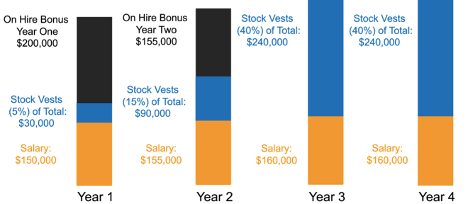This article has been updated for 2022. In February 2022, Amazon increased their maximum base salary from $160,000 to $350,000.
We created this video to help you understand how you get paid at Amazon. If you just started at Amazon, are considering employment, or have been working at the company for a few years and want a better sense for how your salary and RSUs work – this video is for you.
How are Amazon Employees Paid?
There are three different ways Amazon employees are paid:
Base salary: This is very straight-forward, you will receive your base salary every month.
Sign-on bonus: Many new employees will also receive a year one and a year two sign-on bonus. The bonus is paid out with every paycheck, so in essence it’s just additional salary for the first two years you are at Amazon. As a quick example: If you were entitled to a $60,000 year one sign-on bonus, you will receive an additional $5,000 per paycheck. The same method of payment (every paycheck) will occur in year two, simply divide your year two sign-on bonus by twelve.
Restricted Stock Units (RSUs): Stock vests will begin on your first anniversary. You will receive additional stock vests at the end of year 2 and then every 6 months until you’ve been with the company for 4 years. Many Amazon employees receive additional refresher RSUs as an Amazon employee over time. Recently, Amazon announced a 20-1 stock split that is scheduled to take place in June 2022. I discuss the announcement in more detail in this Geekwire article.
How do your salary, on-hire bonuses, and Restricted Stock Units add up?
Before we go through the example of what the numbers and percentages look like, it’s important to mention that total compensation will vary substantially depending on your specific role and level. The total comp package for a new employee coming in at Level 4 will likely look substantially different than someone coming in at Level 8.
In this example, your starting salary is $150,000 with a bump to $155,000 in year two and another bump to $160,000 in year three. You received an on-hire bonus of $200,000 in year one and $155,000 in year two. We will also assume you are entitled to $600,000 in restricted stock units and that the initial stock price does not change. RSUs are distributed at the end of the year for your first two years at Amazon, the distribution frequency changes to every six months in years three and four.
You can see the payout timeline in the chart below:

Here is a little more detail about when to receive your stock vests:
- End of year one – 5% of the initial grant ($30,000)
- End of year two – 15% ($90,000)
- Six months later – 20% ($120,00)
- End of year three 20% ($120,000) for a total of $240,000 in year 3
- Six months later – 20% ($120,000)
- End of year four – 20% ($120,000) for a total of $240,000 in year 4
- Your total stock vests = $600,000
You will notice a big difference in RSUs between years one and two, and years three and four. Your on-hire bonus essentially makes up that compensation difference in the first couple of years with the company. Your year one on-hire bonus is almost always going to be a bit bigger than your year two on-hire bonus, because in the second year you have 10% more of your stock vesting.
You’ll also notice that in years one and two, much more of your Amazon compensation is fixed, whereas the longer you’re with the company the more variable your compensation becomes. This is because the value of your RSUs are directly tied to the stock price of Amazon (remember above when we mentioned the increase to the maximum base salary – this is where you will see the benefit of that change). When it comes to the income generated by your RSUs, obviously, if Amazon does really well, you could experience positive spikes in your compensation. However, if Amazon’s stock price doesn’t do as well, you could see your total compensation remain relatively flat, or if the stock price drops you could see your total compensation go down. We have another article that will provide you with some insight on how to think about investing your Amazon RSUs.
What does an increase to the base salary mean for Amazon employees in the long-term?
On the positive side of things, this means employees may have less of their income tied to RSUs. There are two reasons this can be beneficial:
- You can expect a larger paycheck on a regular basis, making it easier to budget, plan, and save. There is no way of knowing how much income will come from future vesting shares of Amazon stock.
- It will be easier to keep your investment portfolio diversified and to avoid building up a concentrated position of Amazon stock.
On the downside, it may be more challenging for some when it comes to building long-term savings. We realize that many employees use their RSUs as a long-term saving strategy by allowing their RSUs to build up over time. These shares tend to be out of sight, out of mind, which essentially is a form of forced savings. [Not what we recommend this but it happens all the time.] By shifting some of this compensation to a paycheck, it puts more of the savings onus on the employee.
When Amazon announced the base pay increase, they also announced a change for when employees would be compensated after a promotion. Rather than waiting until the next compensation cycle, now managers will review compensation at the time of a promotion, and issue additional stock awards mid-year as warranted. A win for newly promoted Amazon employees!
Long-term Planning for Amazon Employees
We encourage Amazon employees to develop a strategy for managing your RSUs based on your financial goals and needs.